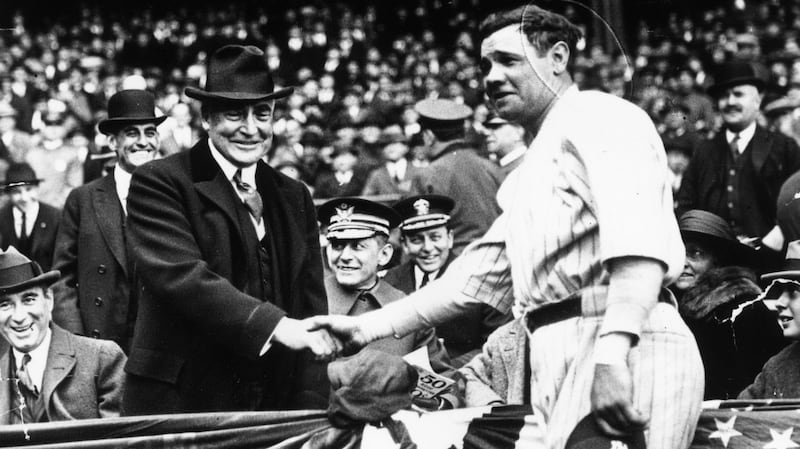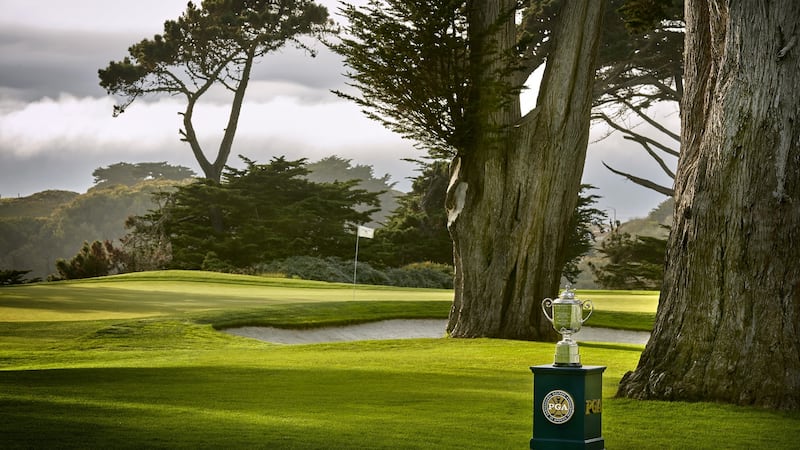Had US president Warren G Harding not been bedridden in those midsummer days of 1923, he might have left his eighth-floor suite at the Palace Hotel in San Francisco and headed to the southwestern edge of the city, where a new golf course named Lake Merced Golf Links was under construction.
Harding was a golfer, after all, and he had travelled thousands of miles by train and ship on his summer-long “Voyage of Understanding.” It was intended to be three months and 15,000 miles of publicity stops. He had played golf only days before in Vancouver.
But Harding never left the Palace Hotel alive again. Whatever good will that he hoped to engender on his trip, whatever hopes he had of winning re-election the next year, ended 2½ years into his largely forgotten presidency.
“Most historians rank Harding as the worst of all American presidents,” according to the University of Virginia’s Miller Center, a nonpartisan think tank devoted to presidential history. But Harding was at the right place at the right time to be linked, improbably, to something as distant as a Major professional golf tournament in 2020.
The first Major men's golf championship of the coronavirus era has arrived, belatedly, in the form of this week's US PGA Championship – a fan-free, made-for-television event scheduled to begin Thursday, starring Tiger Woods, Rory McIlroy, two-time defending champion Brooks Koepka and the world No 1 Justin Thomas, among about 150 others.
Yet the name that promises to be uttered most across the global airwaves this week is Harding. The golf course being constructed seven miles from the president’s deathbed 97 years ago was soon christened Harding Park, during a bygone era when naming things for presidents was done with little debate or consideration.
Harding Park became one of golf’s great, enduring layouts, curiously named for the most disrespected of US presidents. That this most sombre of summers should be linked, even tenuously, to Harding and the strangeness of 1923 feels about right.
Harding, a former Republican senator from Ohio, had little in the way of a platform when he ran for the White House in 1920 other than a “return to normalcy”. He was viewed as a tax-cutting, anti-immigrant nationalist who, in the wake of the first World War, did not want the United States to be part of the postwar League of Nations.

He was rumoured to have had affairs (and at least one out-of-wedlock child) and was soon surrounded by scandal throughout his administration. (Curious? Start by Googling “Teapot Dome”.) He was not considered a deep thinker and was prone to rambling. He liked to play golf.
Still, he and his running mate, Calvin Coolidge, won 60.3 per cent of the popular vote. The Democratic candidate, James M Cox (with Franklin D Roosevelt as the vice-presidential nominee), earned just 34.1 per cent.
Harding’s administration coincided with a boom in American golf and golf-course construction. The game’s popularity hit hard in San Francisco, which had deemed its small, peninsula setting too valuable to hold cemeteries (it had been kicking out the dead for years), but perfect for golf, especially amid the oceanside dunes near Lake Merced.
Alister MacKenzie, the famed Scottish course architect, called it “the finest golfing territory I have seen in America”. Several prestigious (and still private) courses were constructed near one another within a few years, including the San Francisco Golf Club, California Golf Club of San Francisco (which later moved a few miles south) and Lake Merced Golf Club.
The Olympic Club, which has held five US Opens and is the scheduled site of the 2028 PGA Championship and the 2032 Ryder Cup, opened two courses in 1924. Across Lake Merced from the Olympic Club, on what might be the best property of them all, a design by Willie Watson and Sam Whiting was nearly two years from opening when president Harding’s train rolled into San Francisco in the summer of 1923.
About six weeks after Harding’s death, San Francisco’s Harding Memorial Committee decided that the best way to honour the president was with a half-built golf course. Lake Merced Golf Links became Harding Park.
"Nothing could be more appropriate as a tribute to president Harding, as he was a great lover of outdoor recreation," Herbert Fleishhacker, a prominent businessman and the head of the city's parks, said at the time.
The course built a better reputation. It quickly played host to national amateur championships and became a home course for the San Francisco City Championship, whose winners included Ken Venturi, whose parents ran the Harding Park pro shop for years. Harding became a regular stop on the PGA Tour in the 1960s. Winners included Venturi, Gary Player, Billy Casper, Gene Littler and Chi-Chi Rodriguez.

But Harding Park’s prestige was frayed by municipal budgets and neglect. The PGA Tour left, and for most of the next 30 years, the course was loved for its history more than its condition. During the 1998 US Open at the Olympic Club, Harding Park’s fairways served as parking lots.
That embarrassing fate stirred a push to rescue the course’s faded glory, led by Sandy Tatum, a San Francisco lawyer and former USGA president. Rehabilitated and reopened in 2003, and still a municipal course (September tee times for city residents can be had for as little as $64), Harding Park attracted big events again. That included the WGC-American Express Championship in 2005 (won by Tiger Woods in a playoff over John Daly) and the Presidents Cup in 2009 (won by the United States).
This week’s PGA Championship is Harding Park’s first Major. Among all the famous names to be uttered worldwide during its four rounds will be that of a long-ago president, probably without explanation or context. Thankfully, the course is in much better shape than Harding was.
He had left Washington in June, in a 10-car train filled with cabinet members, dignitaries, staff members, reporters and the first lady, Florence Harding. It was part campaign trip, part summer vacation. Harding's speech in St Louis was one of the first presidential addresses to be broadcast live on radio. The train then rolled through Kansas City, Denver and Salt Lake City, among other cities, as it carried the president west. Newspapers covered every mile of it.
Harding, 57, was a tireless tourist, a master of the photo opportunity. He visited Yellowstone and Zion national parks, where haemorrhoids made misery of a horseback ride. He visited a mine, drove a wheat binder, attended a commemoration of the Oregon Trail and, eventually, boarded a US navy transport ship in Seattle to tour the Alaskan territory.
He gleefully watched as the ship’s gunners fired shells into the Taku Glacier to create giant splashes from chunks of falling ice. Then everything turned south. Harding may have been sickened by bad crab in Sitka. He complained privately of abdominal pain and may have caught pneumonia. His golf outing in Vancouver was limited to a few holes. (His visit made a lasting impact; there remains a Harding memorial in the city’s Stanley Park.)
Ominously, the navy ship accidentally rammed an American destroyer in Puget Sound fog. Harding mustered the energy to give a speech in Seattle, but a weekend in Portland, Oregon, was scrapped so the entourage could hurry to San Francisco to get the president medical attention and rest.
Harding was taken to the Palace Hotel and placed in the presidential suite. "He was weak and ill but his condition had improved to an encouraging degree," The New York Times reported as Harding arrived on July 29th. The nation waited for news. Harding's doctor, a homeopath named Charles Sawyer, provided updates. For a couple of days, Harding was in "grave" condition. Other physicians, including Stanford president Ray Lyman Wilbur, were called in.
“President Harding seems to have passed the crisis,” The Times reported atop its front page on August 1st. “His physicians will not say that he is out of danger, but even through their cautious comment it is plainly perceptible that they believe that there is little chance of a recurrence of the dangerous symptoms which threatened the life of the President last night.”
That made the August 3rd headline in the San Francisco Chronicle so stunning. “HARDING DEAD” it read in huge letters. Florence Harding had been reading aloud to her husband an article from The Saturday Evening Post about him entitled, “A Calm View of a Calm Man.”
"Oh, that's good," the president supposedly said about one passage. "Go on." Those were his last words, apparently. "Suddenly and without warning, a shudder passed over the president's body," the Chronicle reported. "He raised one arm, but not a word came from his lips. The arm dropped back and the president lay still." Florence Harding screamed. Officials rushed in, led by the secretary of commerce Herbert Hoover. Vice-president Coolidge, at home in Vermont, was sworn in overnight.
The cause of Harding’s death was initially ruled “apoplexy,” but rumours spread – about poor care from his doctors, about his many other ailments. Some still believe that the first lady poisoned her husband, maybe as revenge for his infidelities. She refused to allow an autopsy.
Most historians today think he had a heart attack. Harding’s body was taken from the Palace Hotel, placed aboard a train back to Washington DC, and interred in his hometown, Marion, Ohio. There are not a lot of things named for Harding these days – schools, mostly, and Harding Township, New Jersey, among them – though there is a Harding Golf Course in Los Angeles that opened in 1923. (It is next to Wilson Golf Course, opened in 1927, and named for Harding’s presidential predecessor, who died about six months after Harding.)
In San Francisco, the biggest recognition of Harding’s place in city history is at a now-famous golf course that he never played or visited. But it does help keep his name alive, rarely more than this week. – New York Times










